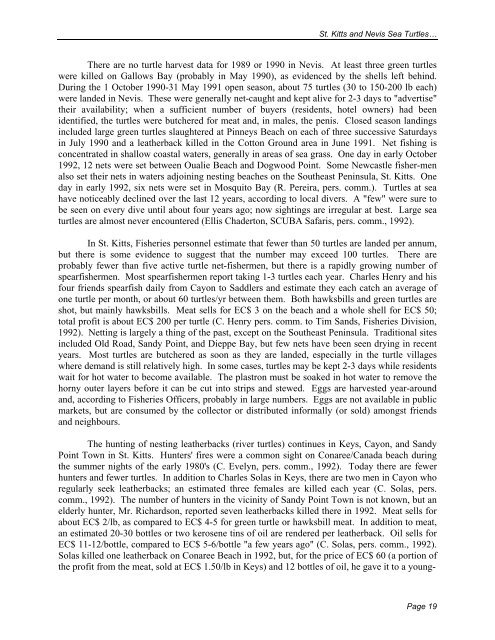Sea Turtle Recovery Action Plan for St. Kitts and Nevis - WIDECAST
Sea Turtle Recovery Action Plan for St. Kitts and Nevis - WIDECAST
Sea Turtle Recovery Action Plan for St. Kitts and Nevis - WIDECAST
You also want an ePaper? Increase the reach of your titles
YUMPU automatically turns print PDFs into web optimized ePapers that Google loves.
<strong>St</strong>. <strong>Kitts</strong> <strong>and</strong> <strong>Nevis</strong> <strong>Sea</strong> <strong>Turtle</strong>s…<br />
There are no turtle harvest data <strong>for</strong> 1989 or 1990 in <strong>Nevis</strong>. At least three green turtles<br />
were killed on Gallows Bay (probably in May 1990), as evidenced by the shells left behind.<br />
During the 1 October 1990-31 May 1991 open season, about 75 turtles (30 to 150-200 lb each)<br />
were l<strong>and</strong>ed in <strong>Nevis</strong>. These were generally net-caught <strong>and</strong> kept alive <strong>for</strong> 2-3 days to "advertise"<br />
their availability; when a sufficient number of buyers (residents, hotel owners) had been<br />
identified, the turtles were butchered <strong>for</strong> meat <strong>and</strong>, in males, the penis. Closed season l<strong>and</strong>ings<br />
included large green turtles slaughtered at Pinneys Beach on each of three successive Saturdays<br />
in July 1990 <strong>and</strong> a leatherback killed in the Cotton Ground area in June 1991. Net fishing is<br />
concentrated in shallow coastal waters, generally in areas of sea grass. One day in early October<br />
1992, 12 nets were set between Oualie Beach <strong>and</strong> Dogwood Point. Some Newcastle fisher-men<br />
also set their nets in waters adjoining nesting beaches on the Southeast Peninsula, <strong>St</strong>. <strong>Kitts</strong>. One<br />
day in early 1992, six nets were set in Mosquito Bay (R. Pereira, pers. comm.). <strong>Turtle</strong>s at sea<br />
have noticeably declined over the last 12 years, according to local divers. A "few" were sure to<br />
be seen on every dive until about four years ago; now sightings are irregular at best. Large sea<br />
turtles are almost never encountered (Ellis Chaderton, SCUBA Safaris, pers. comm., 1992).<br />
In <strong>St</strong>. <strong>Kitts</strong>, Fisheries personnel estimate that fewer than 50 turtles are l<strong>and</strong>ed per annum,<br />
but there is some evidence to suggest that the number may exceed 100 turtles. There are<br />
probably fewer than five active turtle net-fishermen, but there is a rapidly growing number of<br />
spearfishermen. Most spearfishermen report taking 1-3 turtles each year. Charles Henry <strong>and</strong> his<br />
four friends spearfish daily from Cayon to Saddlers <strong>and</strong> estimate they each catch an average of<br />
one turtle per month, or about 60 turtles/yr between them. Both hawksbills <strong>and</strong> green turtles are<br />
shot, but mainly hawksbills. Meat sells <strong>for</strong> EC$ 3 on the beach <strong>and</strong> a whole shell <strong>for</strong> EC$ 50;<br />
total profit is about EC$ 200 per turtle (C. Henry pers. comm. to Tim S<strong>and</strong>s, Fisheries Division,<br />
1992). Netting is largely a thing of the past, except on the Southeast Peninsula. Traditional sites<br />
included Old Road, S<strong>and</strong>y Point, <strong>and</strong> Dieppe Bay, but few nets have been seen drying in recent<br />
years. Most turtles are butchered as soon as they are l<strong>and</strong>ed, especially in the turtle villages<br />
where dem<strong>and</strong> is still relatively high. In some cases, turtles may be kept 2-3 days while residents<br />
wait <strong>for</strong> hot water to become available. The plastron must be soaked in hot water to remove the<br />
horny outer layers be<strong>for</strong>e it can be cut into strips <strong>and</strong> stewed. Eggs are harvested year-around<br />
<strong>and</strong>, according to Fisheries Officers, probably in large numbers. Eggs are not available in public<br />
markets, but are consumed by the collector or distributed in<strong>for</strong>mally (or sold) amongst friends<br />
<strong>and</strong> neighbours.<br />
The hunting of nesting leatherbacks (river turtles) continues in Keys, Cayon, <strong>and</strong> S<strong>and</strong>y<br />
Point Town in <strong>St</strong>. <strong>Kitts</strong>. Hunters' fires were a common sight on Conaree/Canada beach during<br />
the summer nights of the early 1980's (C. Evelyn, pers. comm., 1992). Today there are fewer<br />
hunters <strong>and</strong> fewer turtles. In addition to Charles Solas in Keys, there are two men in Cayon who<br />
regularly seek leatherbacks; an estimated three females are killed each year (C. Solas, pers.<br />
comm., 1992). The number of hunters in the vicinity of S<strong>and</strong>y Point Town is not known, but an<br />
elderly hunter, Mr. Richardson, reported seven leatherbacks killed there in 1992. Meat sells <strong>for</strong><br />
about EC$ 2/lb, as compared to EC$ 4-5 <strong>for</strong> green turtle or hawksbill meat. In addition to meat,<br />
an estimated 20-30 bottles or two kerosene tins of oil are rendered per leatherback. Oil sells <strong>for</strong><br />
EC$ 11-12/bottle, compared to EC$ 5-6/bottle "a few years ago" (C. Solas, pers. comm., 1992).<br />
Solas killed one leatherback on Conaree Beach in 1992, but, <strong>for</strong> the price of EC$ 60 (a portion of<br />
the profit from the meat, sold at EC$ 1.50/lb in Keys) <strong>and</strong> 12 bottles of oil, he gave it to a young-<br />
Page 19
















